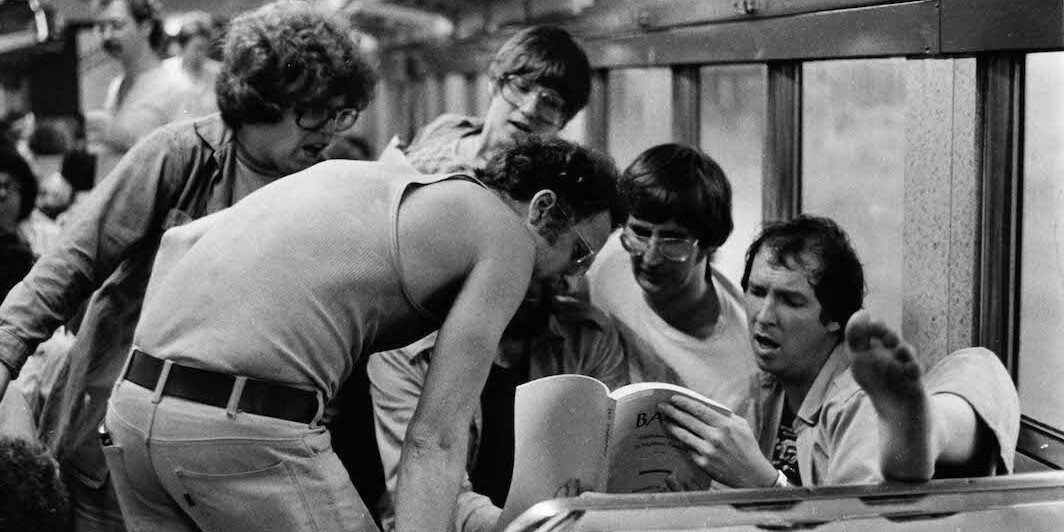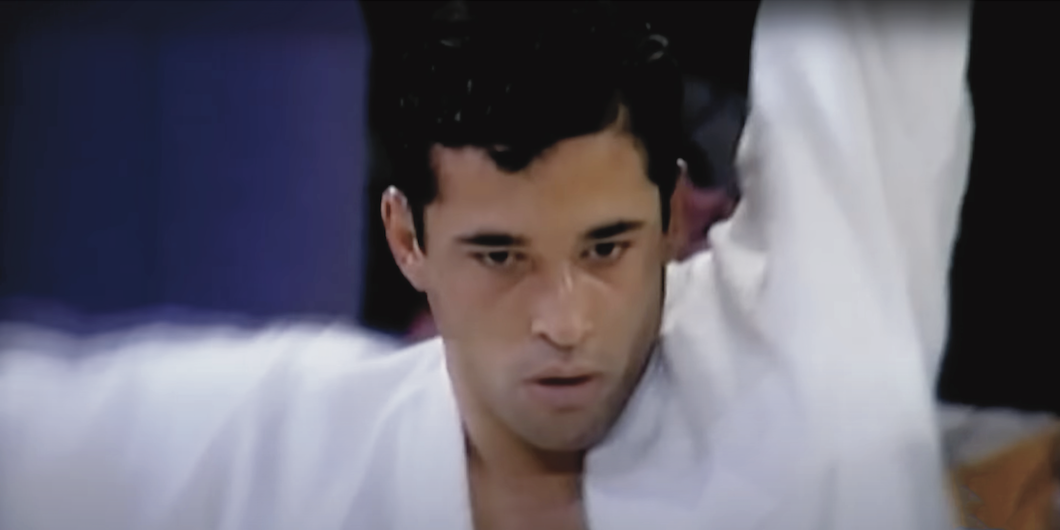IN THE SULLIVANIANS: SEX, PSYCHOTHERAPY, AND THE WILD LIFE OF AN AMERICAN COMMUNE, journalist Alexander Stille follows whispers of a psychoanalytic cult and breaks open the story of how psychotherapy escaped the consulting room and became the total environment of its patients. The book centers on Saul Newton, a therapist turned charismatic leader who directed a collective search for liberation through analysis and communal living. Needless to say, it all went horribly wrong.
- print • Summer 2023
- print • Summer 2023
BETWEEN 1956 AND 1967, the Coenties Slip on the lower tip of Manhattan was home to a group of artists who had moved to the city with grand ambitions for their work and little money to their names. In those lean years, before they were canonized, Robert Indiana, Ellsworth Kelly, Agnes Martin, James Rosenquist, Lenore Tawney, Jack Youngerman, and Delphine Seyrig all took up residence in this “down downtown,” on a dead-end street on the East River where they nested themselves among fishing ships and sailors, the changing tides and unremitting grime, living at a remove from the New York
- print • Summer 2023
Edvard Munch, Todeskuss (The Kiss of Death), 1899, lithograph, 173⁄4 x 241⁄2″. BOOKFORUM IS BACK. We’ve been on hiatus since December 2022, and the Summer 2023 edition is the first issue produced in conjunction with our new publishing partner, The Nation, a venerable magazine committed to fiercely independent journalism. Our mission is to continue the conversation […]
- print • Summer 2023
IF YOU WERE TO HAVE TWO MEN FIGHT EACH OTHER with a minimum of rules, should they do it in a boxing ring, or a plexiglass cube, or a cage (and maybe an electrified one)? These were the novel logistical questions faced by the founders of the Ultimate Fighting Championship, including a used-car salesman turned ad mogul and a Brazilian described by Playboy as “the toughest man in the United States,” as they attempted to identify what form of martial art was most effective at incapacitating an opponent. Inspired by a Chuck Norris flick, they chose the cage—no electricity—to determine
- print • Summer 2023
AMONG THE OLDEST REFERENCES to menstruation in literature is in the book of Genesis, in a story about a lie. Rachel stole her father’s household gods, it goes, and when he came to retrieve them, she threw a covering over the objects and sat on it. She couldn’t stand, she apologized to her father, because she was in “the way of women.” At the end of the sixteenth century, an English clergyman clarified in his guide to Genesis that Rachel wasn’t pretending to be incapable of standing, just uncomfortable, due to her “monethly custome,” an ancestor to our contemporary “period.”
- print • Summer 2023
WHEN A DEER, A DOE, STEPPED INTO THE ROAD perhaps a hundred and twenty feet ahead of the car I was driving, it seemed for a moment that she would die, even though, during the same moment, I did not feel afraid that I would hit her. I was calm; I returned my smoking hand to the steering wheel; I braked. The deer seemed to be looking at me. There was a chance she might actually run toward me. I switched off the high-beams. All of this happened in two and a half seconds, before the deer continued across the road,
- print • Summer 2023
And I’m not sure why I’m infatuated with death.
- print • Summer 2023
IN OSCAR WILDE’S “The Critic as Artist,” Ernest cajoles his friend Gilbert off the piano bench and into an armchair for a discussion, as the original title of the mock-Socratic dialogue would have it, of the “function and value of criticism.” Over the course of an evening passed in the library of his Piccadilly town house, Gilbert, an incorrigible contrarian, pours glass after glass of epigram, paradox, and hyperbole down the throat of Ernest’s received ideas until they can no longer stand up.
- print • Summer 2023
COME BACK WITH ME, children, to a New York before David Zwirner was Robert Moses, when nobody was watching and a “slightly hunchback, short, magical-looking” buddy from the Pacific Northwest could flood the caves of independent film with color and mayhem. Care was different then—the Hotel Chelsea wouldn’t kick you out for setting off the fire alarm and Allen Ginsberg was keeping visionaries in milk and blankets on 12th Street. The buddy from Washington State was Harry Smith, and John Szwed has ably shaped his chaos for the first full biography, Cosmic Scholar. What remains to be determined—and will be partly
- • June 22, 2023
We are thrilled to announce that, after a brief hiatus, Bookforum is returning under new ownership. If you care about our magazine’s mission, please show your support by getting a subscription today. You will get four print issues per year, beginning with our Summer 2023 issue in August. Bookforum has long staked out new territory in the […]
- • Dec/Jan/Feb 2023
IT IS MY FAULT and only mine if I keep Gordon Matta-Clark as a personal Jesus, but the story flies. Matta-Clark died, way too early, at the age of thirty-five in 1978, and spent a chunk of his time slicing up abandoned buildings, which is very Jesus-y. One of his building cuts has become a permanent part of Manhattan’s west side—of that, more soon—and he even contributed to New York’s proudest category of impermanence: the restaurant. (RIP Food, Soho, 1971–1989.) Matta-Clark was tuned to frequencies prophetic in nature and number: the glow of decay, the need to befriend ghosts, and
- • Dec/Jan/Feb 2023
PINUPS ARE RUMORED TO EMERGE FROM THE SEA, mer-peoples caught between nautical and earthly existence, so that maybe there are fewer black pinups circulating in popular culture, because the sea for us is in part the graveyard of the Middle Passage, not just an escapist fantasy. Black pinups would emerge blood-drenched and haunting, rather than seducing onlookers. Just bypass the trance of glamour and observe Josephine Baker’s double consciousness in any photograph, at once entertaining you and devastating you, silly and caustic with grief. Or just look at Prince and try not to fall in love. Hilton Als’s account of
- • Dec/Jan/Feb 2023
IN A TEACHING MANUAL she wrote in the 1980s, the artist Sybil Andrews stressed the importance of reaching into an image for its essence, stripping away whatever stagnated it. “Can you catch that? Can you get that sense of movement?” she would ask. The advice revealed a design philosophy that had defined her work for decades: her 1931 linocut In Full Cry shows a row of horses leaping over a hedge, their riders’ coattails soaring behind them. The lines themselves are Andrews’s subject, vigorous and unflinching. “I don’t draw the horse jumping,” she said. “I draw the jump.”
- • Dec/Jan/Feb 2023
IT IS FITTING THAT BRUCE ADAMS’S NEW BOOK, the sardonically titled You’re with Stupid: kranky, Chicago, and the Reinvention of Indie Music, begins at Jim’s Grill on the North Side: it was the first place I remember seeing a promotional poster for this new band, the Smashing Pumpkins, who were regular customers of Bill Choi’s Korean-inspired restaurant when they were first starting out.
- • Dec/Jan/Feb 2023
Pierre Fatumbi Verger, Colonial Park Pool, Harlem, New York, 1937. © Pierre Fatumbi Verger BORN IN 1902, Pierre Verger became a successful photojournalist in his native France, in 1934 cofounding an agency whose members included the likes of Robert Capa and Henri Cartier-Bresson. He lived mainly in Brazil from 1946 until his death fifty years later, […]
- • Dec/Jan/Feb 2023
AS A CHILD, I dreamed I would one day become a fashion designer. It’s one of those gigs, like astronaut or firefighter, that seems fun until you get too old to overlook the occupational hazards. For fashion, the dangers have long been hidden. In recent years, news coverage of “fast fashion,” a deceptively light term for cheaply manufactured clothing that pollutes landfills and oceans while exploiting and endangering workers, has proliferated—while solutions have not. The disconnect is understandable though hardly excusable: consumers look to material goods to change the way they feel, and fashioning a new sense of self doesn’t usually
- • Dec/Jan/Feb 2023
Frank Bowling, Doughlah G.E.P., 1968–71, acrylic on canvas, 90 × 71 7∕8″. © Frank Bowling. All rights reserved, DACS/Artimage, London & ARS, New York. Courtesy Museum of Fine Arts, Boston IN 1969 THE BRITISH-GUYANESE painter Frank Bowling curated a show at the art gallery of Stony Brook University that included, along with himself, five African […]
- • Dec/Jan/Feb 2023
Salman Toor, Crying Boy with Candle, 2021, oil on panel, 16 × 12″. Echoing the murky sheen of sidewalk puddles, Salman Toor’s paintings revel in the absinthe-green palette of inebriation and hallucination. His compositions whisper of the dark delights of unlit alleyways, of clandestine trysts in the garden, or the unexpected thwack of a cricket […]
- • Dec/Jan/Feb 2023
LAST WEEKEND I WENT to a party where people were wearing black lipstick, tropical shirts, chokers, and little drink umbrellas behind their ears. That was because the theme was “Hot Topic in the Tropics.” Many of the same people had recently been at another party where we danced on an Astroturf rooftop at a house rumored to be owned by the daughter of a famous dead novelist where there was a bathtub full of beers. Most of us had met at a succession of parties held in different cities over the course of more than a decade: birthday parties, magazine parties,
- • Dec/Jan/Feb 2023
WHO WAS BUNNY MELLON? A photo caption in the opening pages of the new book I’ll Build a Stairway to Paradise: A Life of Bunny Mellon (Farrar, Straus and Giroux, $40), by her erstwhile ghostwriter-cum-biographer Mac Griswold, describes her simply as “icon and woman.” More specifically, Mellon was a lifestyle pioneer, for whom the domestic space—the garden and home, with its antiques and art, but also its mood, energy, and ambience—was a Gesamtkunstwerk. She didn’t simply throw parties, she transported guests into ephemeral realms. As a mentor and bestie to First Lady Jackie Kennedy, she helped mold the aesthetic of



















